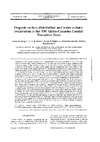Please use this identifier to cite or link to this item:
https://accedacris.ulpgc.es/jspui/handle/10553/1013
| Title: | Organic carbon distribution and water column respiration in the NW Africa-Canaries Coastal Transition Zone | Authors: | Arístegui, Javier Barton, Eric D. Montero, María F. García Muñoz, Mercedes Escánez, J. |
Keywords: | Respiración Océano Corrientes marinas Ciclo del carbono Canarias |
Issue Date: | 2003 | Project: | CANIGO (MAS3.CT96-0060), UE COCA (REN2000-U47 1- C02-02-MAR) |
Journal: | Aquatic Microbial Ecology | Abstract: | The Canary Current (CC) is characterised by strong disruption of its flow by the Canaries Archipelago, which extends across the prevailing flow. In the Coastal Transition Zone (CTZ) downstream of the islands, a region of high mesoscale activity connects the eutrophic waters of the NW Africa coastal upwelling (UW) system with the oligotrophic open ocean waters of the eastern subtropical North Atlantic gyre (ESNA). We studied the distribution of particulate (POC) and dissolved organic carbon (DOC) and carbon remineralization rates in the 0 to 1000 m water column of this transitional region to assess its role in horizontal and vertical export of organic matter. The epipelagic waters (0 to 200 m) of the CTZ are characterised by higher mean surface integrated concentrations of POC (0.8 +/- 0.4 mol C m(-2)) and DOC (17 +/- 7 Mol C m(-2)), and by higher community respiration (R > 100 mmol C m(-2) d(-1)) than the ESNA or UW waters. Integrated R was much lower (7 +/- 3 mmol C m(-2) d(-1)) in the mesopelagic zone (200 to 1000 m), indicating that most of the organic matter was respired in the upper 200 m, with little being transported downwards. Nevertheless, peaks in DOC and R were observed at 300 to 600 m depth, coinciding with the depth of the deep scattering layer. These relative maxima were particularly important in the case of DOC, reaching concentrations comparable to surface waters (> 80 muM), In spite of this, DOC contributed only 26.5% to the apparent oxygen utilisation (AOU) in the mesopelagic zone. Correlations between R and particulate-and dissolved organic matter suggest that respiration was mainly supported by particulate material at surface and deep waters. We compared plankton metabolic balances along the UW, CTZ and ESNA. Our analyses show that during summer time, and probably during most of the year, the ESNA and CTZ behave as net heterotrophic regions. In spite of a relatively high primary production (P) favoured by mesoscale activity in the CTZ, plankton R clearly exceeds P as result of the excess carbon advected from the coastal UW. However, a significant amount of non-respired carbon must be transported from the CTZ to the open ocean to account for part of the surface metabolic imbalance between P and R reported for the ESNA. | URI: | https://accedacris.ulpgc.es/handle/10553/1013 | ISBN: | 9483055 | ISSN: | 0948-3055 | DOI: | 10.3354/ame033289 | Source: | Aquatic Microbial Ecology[ISSN 0948-3055],v. 33, p. 289-301 |
| Appears in Collections: | Artículos |
SCOPUSTM
Citations
42
checked on Jun 8, 2025
WEB OF SCIENCETM
Citations
39
checked on Jun 8, 2025
Page view(s)
165
checked on Mar 15, 2025
Download(s)
259
checked on Mar 15, 2025
Google ScholarTM
Check
Altmetric
Share
Export metadata
Items in accedaCRIS are protected by copyright, with all rights reserved, unless otherwise indicated.
